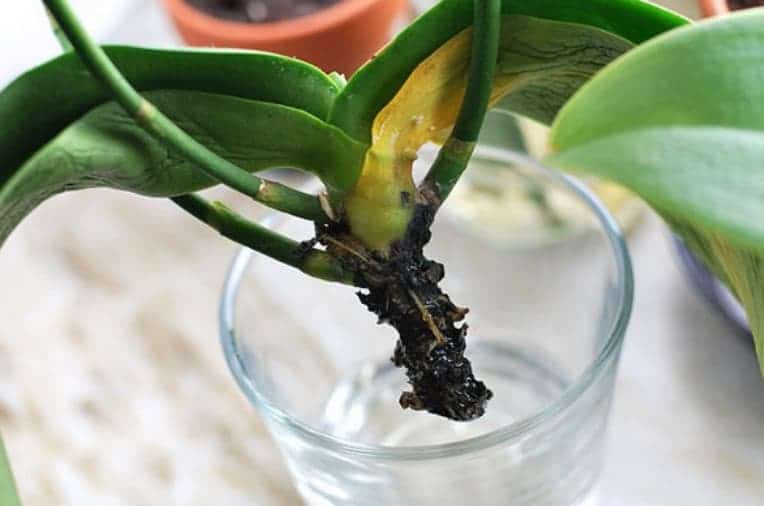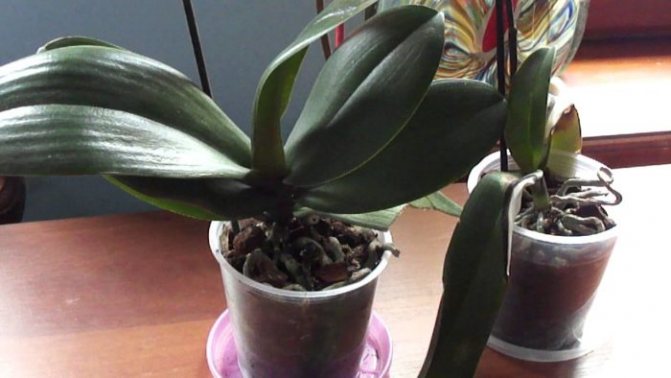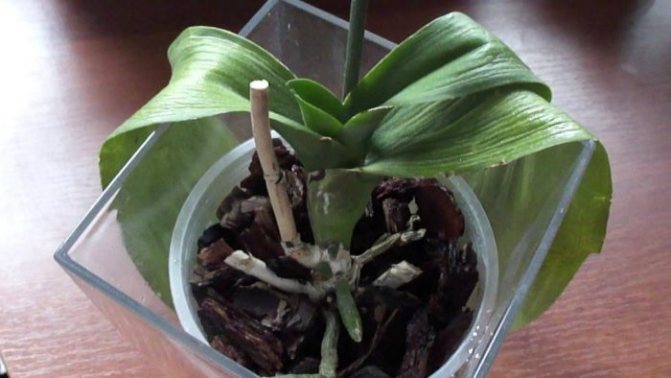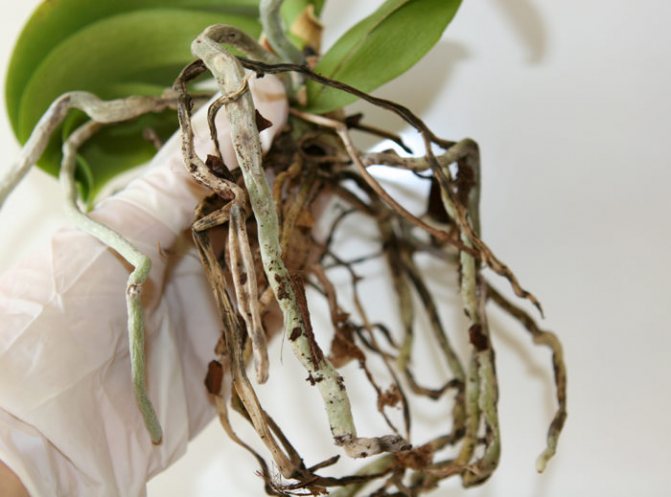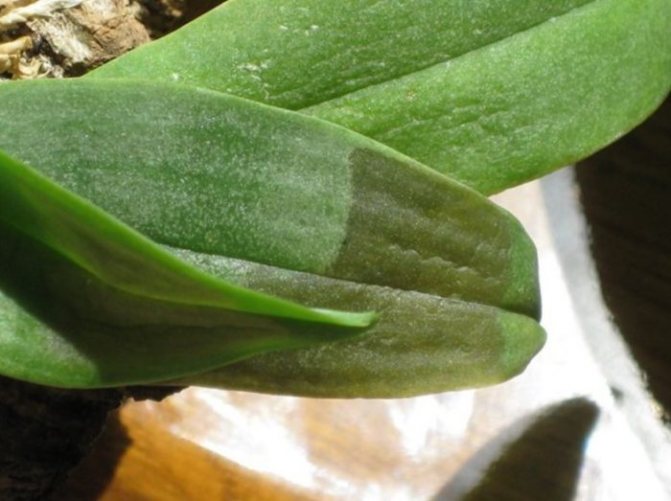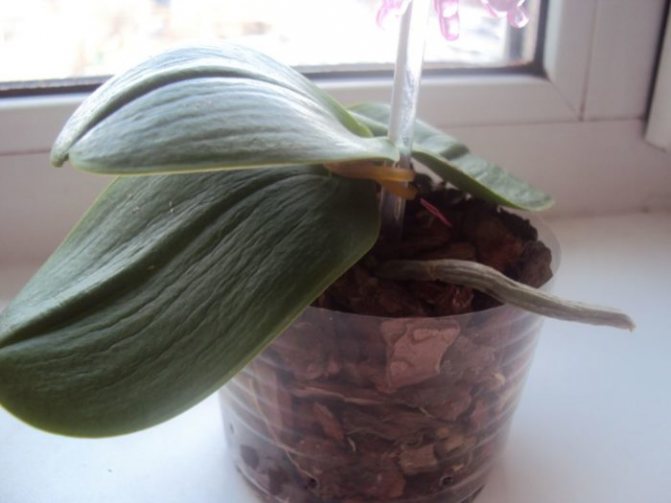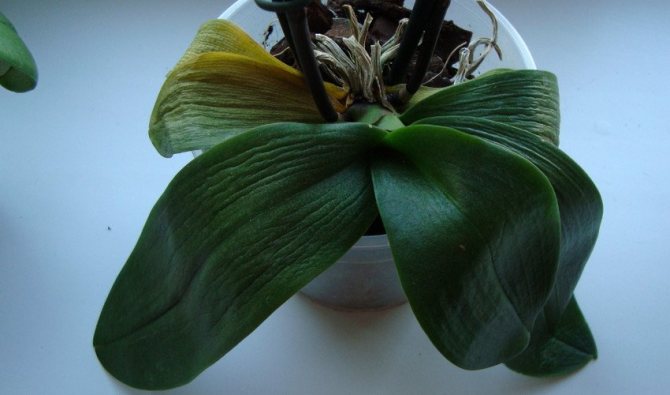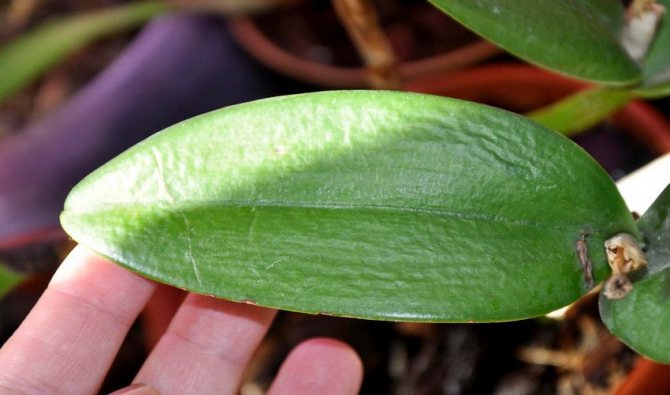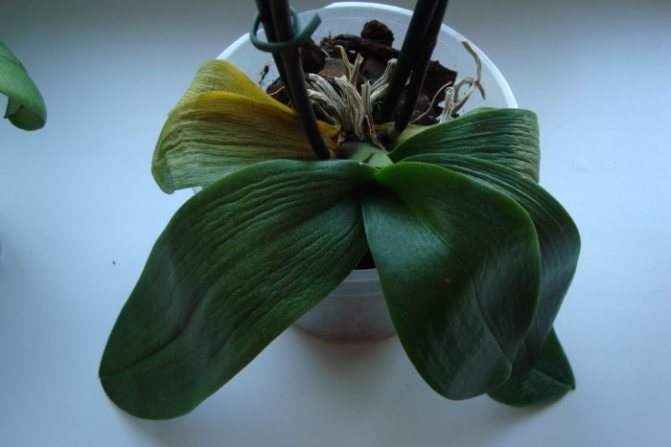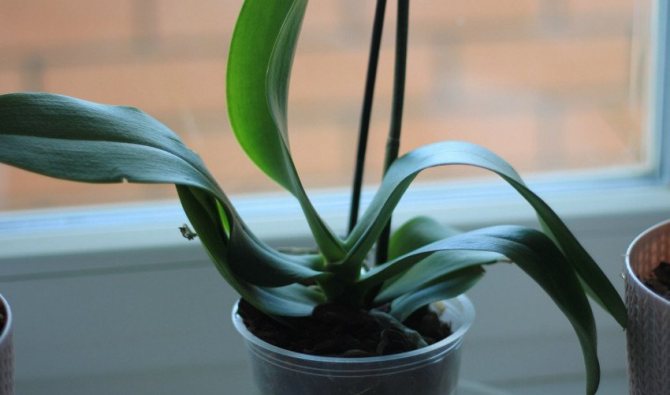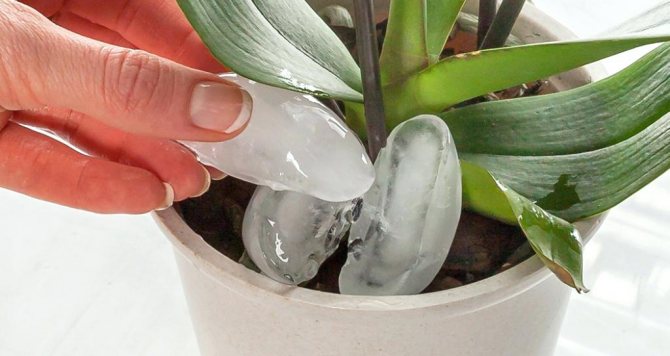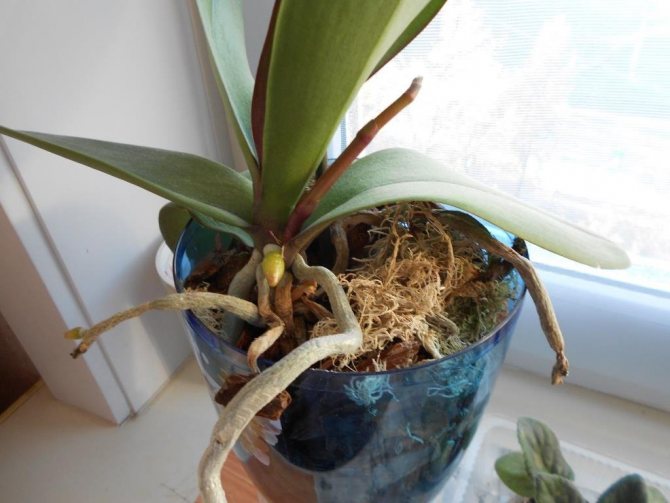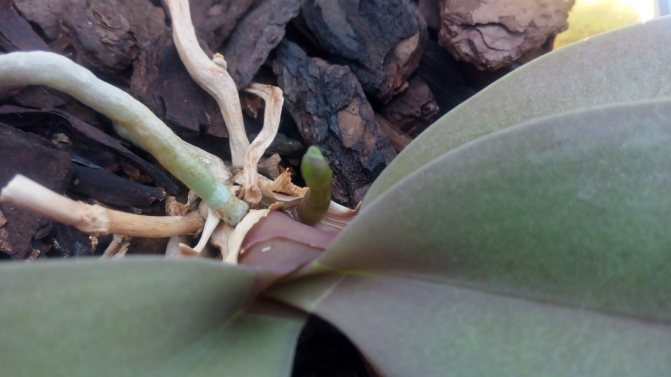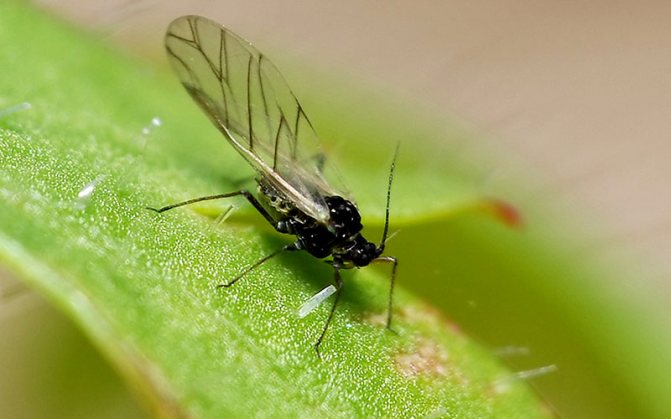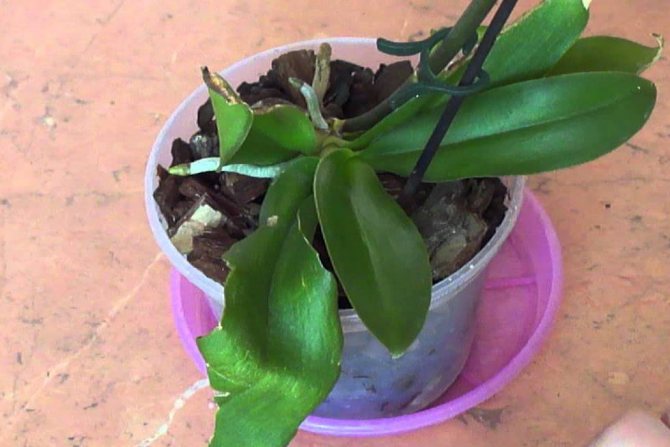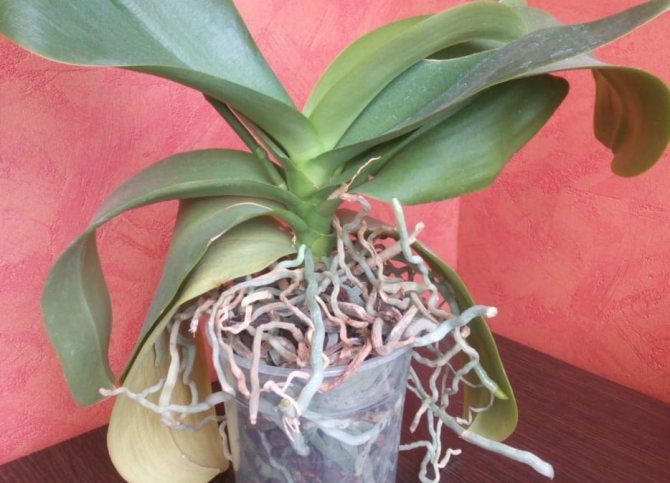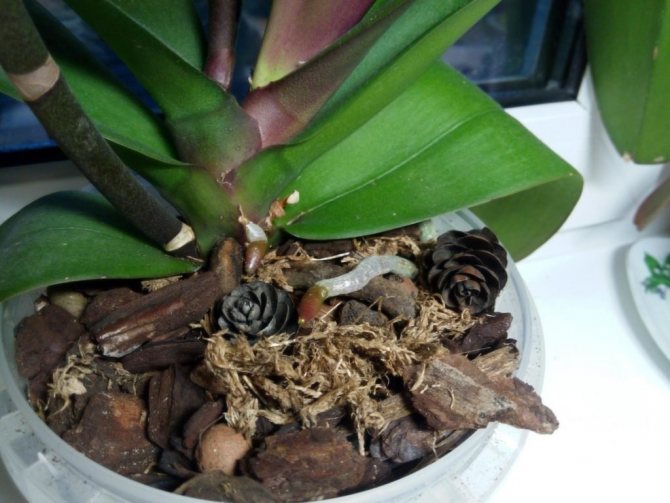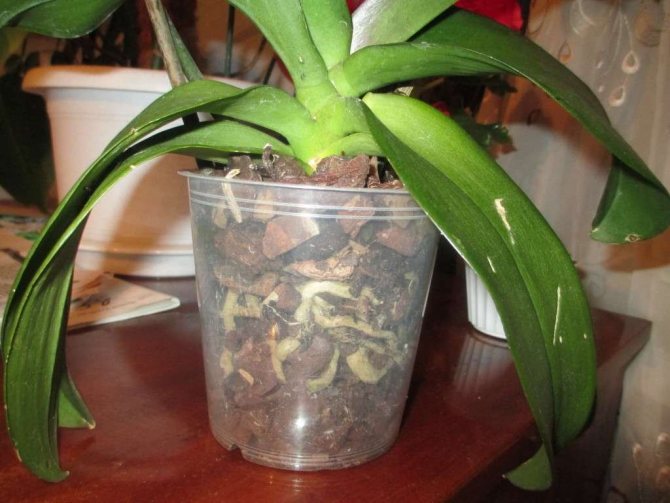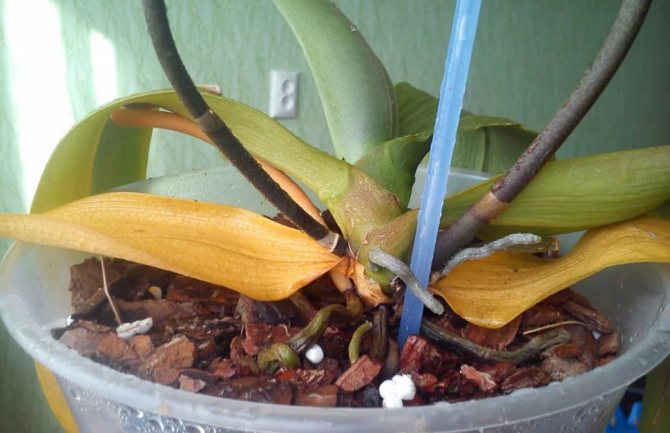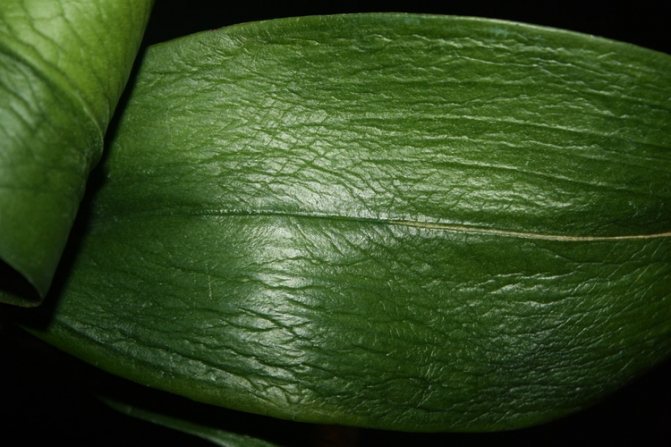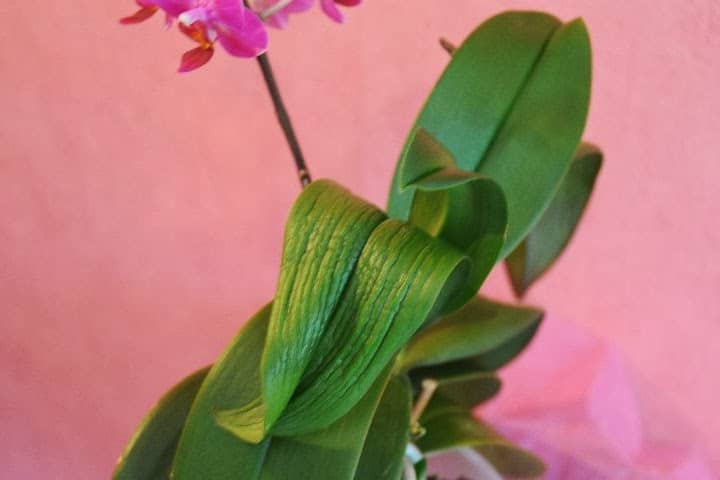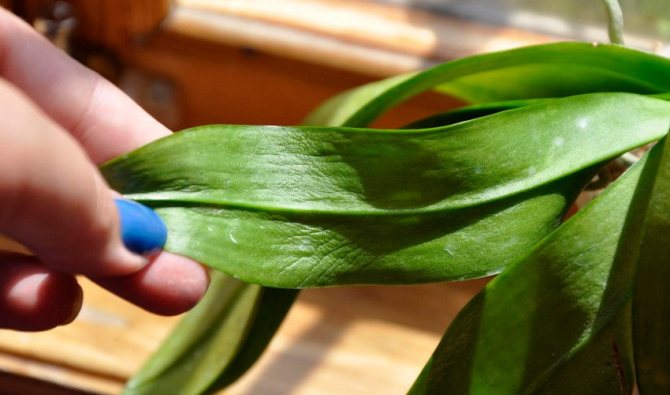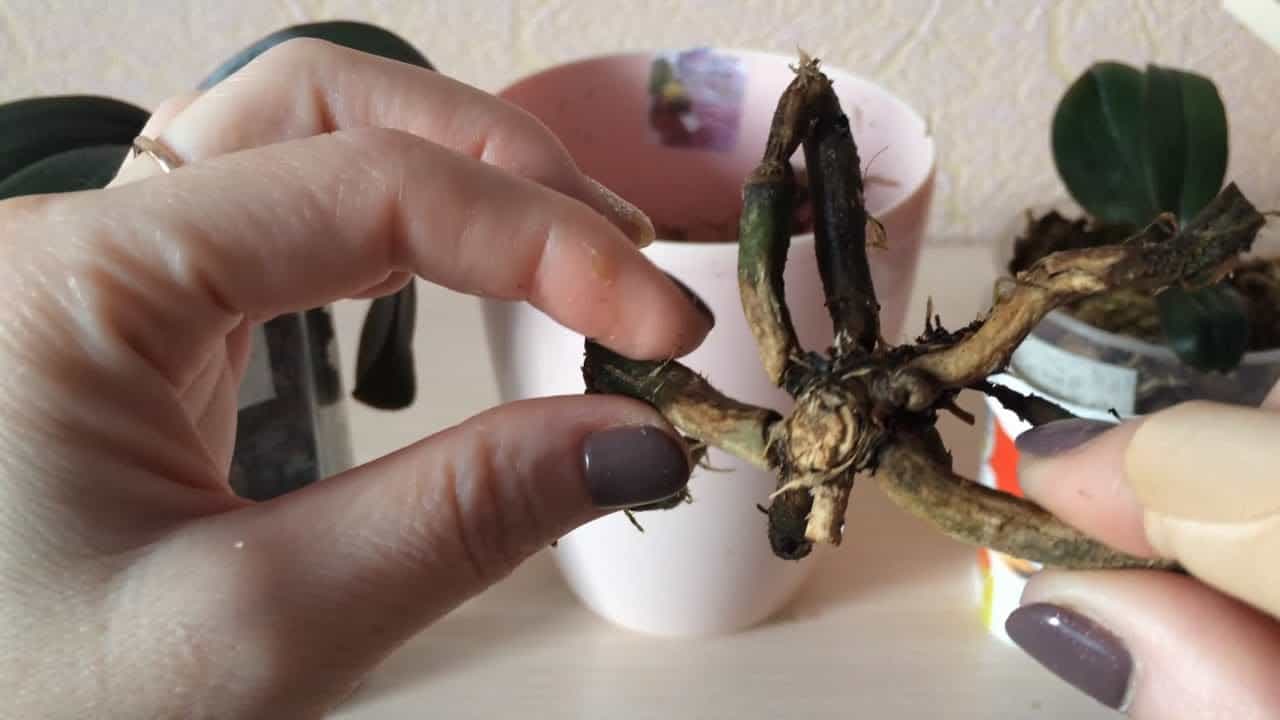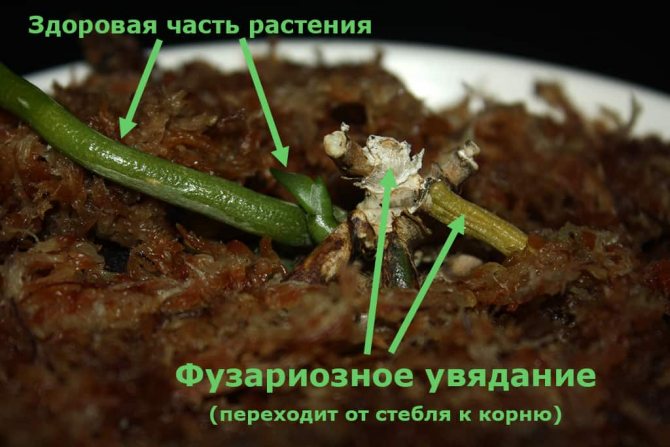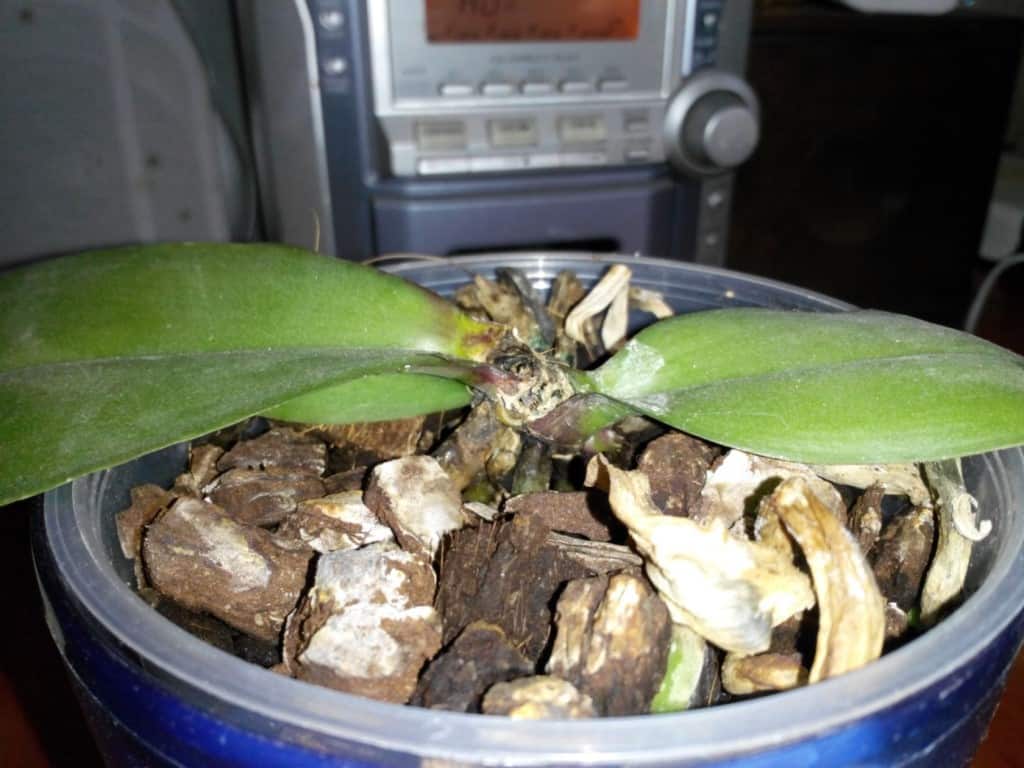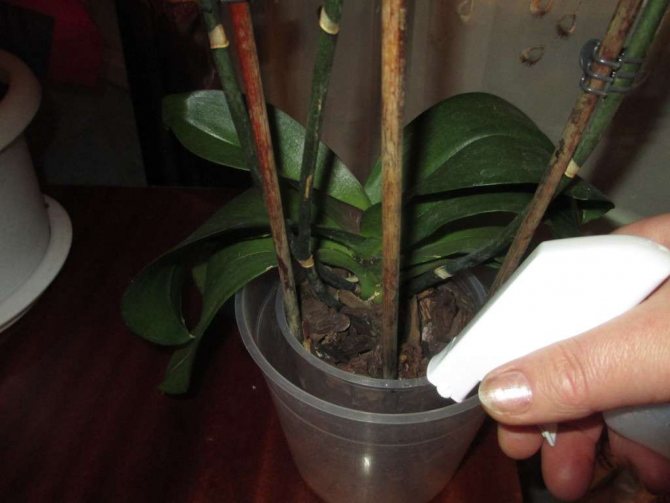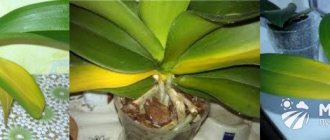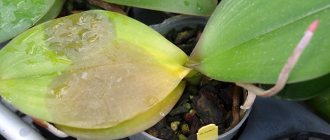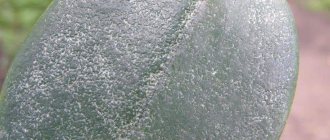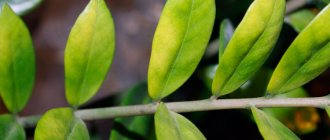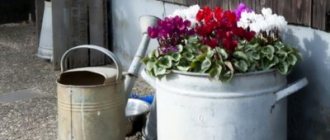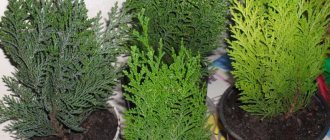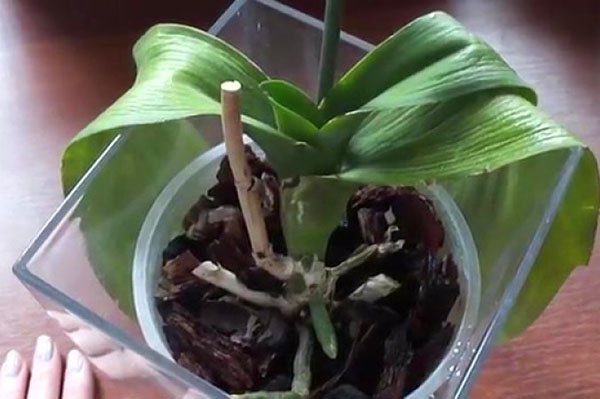
It happens that a healthy, prosperous plant suddenly loses the elasticity of its leaves. Why does the orchid have sluggish leaves, what should I do to restore turgor? There are several reasons and it will take time to restore beauty. It is clear that since the castings have lost their elasticity, the biochemical processes in the system are disrupted. Lack of moisture, overheating of the plant, or root diseases are the main reasons why an orchid withers. If you do not take action, the leaves will turn yellow, the plant will die.
We set the temperature regime
Phalaenopsis dries up if it is exposed to direct sunlight for a long time, or is in a room where it is hot. As a result, the roots of the plant are overcooled due to lack of moisture, and the leaves first wither and then turn yellow. If this happens, move the plant to a cool, shaded place as soon as possible for several hours. Only after the phalaenopsis has completely cooled down can it be watered or sprayed.
Try not to allow repeated overheating, otherwise your pet may dry out and then die completely. The optimum temperature for a plant should be within +25 degrees during the day, +15 degrees at night. It will not be superfluous to organize a protective canopy from the sun over the plant, if there is absolutely nowhere to rearrange it.
The main causes of wilting
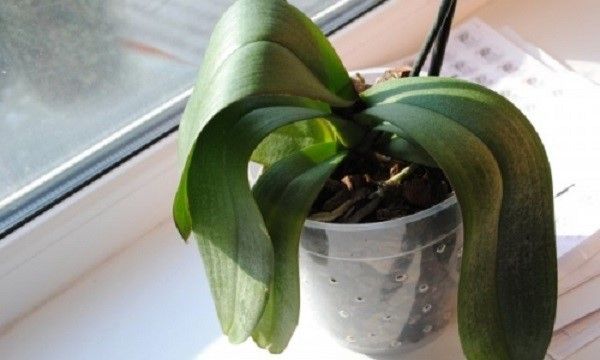

Critical temperatures
The plant does not tolerate direct sunlight in hot summer. They do a lot of harm to the orchid after dinner. Wrinkled leaves, from which moisture is released, signal that the flower is overheated. In this case, too much moisture is released, the roots do not have time to absorb it, as a result of which the leaves become soft.
In order for the plant to recover, it must be transferred to the shade. Spray the foliage carefully so that no water gets on the flowers. If you ignore this problem, the orchid will die.
When growing this plant, it is especially important to monitor the temperature regime in summer. In the cold season, nothing should be threatened. If the leaves do wither, it is possible that the roots are overheating from the batteries that heat the windowsill. Overheating has the same detrimental effect on the plant as direct sunlight. Due to strong heating, moisture evaporates quickly, and the roots constantly lack it.
You can remedy the situation with a double pot. Drainage holes are made in the inner container, and the outer one must be completely sealed. Cover the bottom of the outer pot with pebbles or expanded clay. Excess water will go to the pebbles, and evaporate, moisten the roots, which will not allow the soil to overheat.
Lack or excess of moisture
Improper watering is a common cause of foliage wilting. Both overdried soil and excessive moisture are dangerous for the plant. In fact, it is very easy to dry out the soil mixture. The microclimate in the room is constantly changing, so it is not always possible to keep track of this. You can determine the problem by moving the plant - if it practically does not move, then the soil is dry. If this happens, place the orchid directly in the pot for half an hour in warm water, then remove and let the excess liquid drain. Water the plant when the top layer dries up.It is important that the soil remains loose at all times.
If the flower is poured, its roots will begin to rot. The problem is compounded by the fact that it is not immediately visible. An orchid can even bloom with a diseased root system. When the weakened roots can no longer feed the plant, the leaves will begin to wilt. In this case, an immediate transplant is required. The old substrate is cleaned off the roots, all damaged parts are cut off, washed thoroughly with water, allowed to dry a little and planted in a new soil mixture. Experienced growers recommend treating the cinnamon cuts.
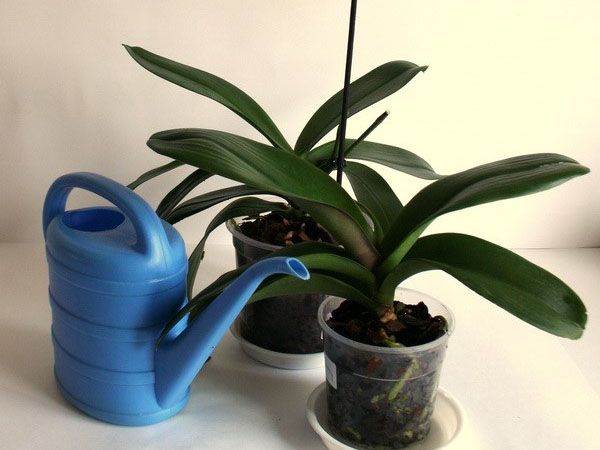

Root system problem
If you have watered your flower enough, observe the temperature regime, and the leaves are not going to recover, then the problem is in the root system. Interestingly, the orchid is a very tenacious flower. The plant recovers even if it has only 5 cm of healthy root. And even if there are no roots left at all, it is worth trying to revive the beauty.
Soft leaves indicate that the orchid lacks calcium or phosphorus. Stir the plant gently in the pot - if it staggers like a bad tooth, then the roots are in a deplorable state.
Remove the flower from the container and carefully examine the roots. Remove dry, rotten, mucus-covered parts with a sharp knife, only healthy tissue should remain. Treat the sections with any antiseptic that does not contain alcohol. Refrain from feeding while the wounds are healing.
The presence of pests or diseases
The leaves of a room orchid can wither due to damage to the plant by a viral, bactericidal or fungal infection. If you suspect that your flower is infected, then first it should be isolated from its "congeners", as the infection spreads quickly.
The disease should be dealt with depending on the pathogen. For the treatment of bacterial diseases, reduce watering, reduce indoor humidity and increase air circulation. The instrument is treated with an antiseptic, and then the affected tissue is removed. After that, within 5 days, they are treated with a bactericidal agent. Viral infections are treated by removing the lesion and creating a favorable environment.
In an orchid affected by a fungus, the lesions are removed with a sterile pruner. After the wounds have healed, the plant is treated with a fungicide in a concentrated form for medicinal purposes.
Poor quality soil
Excessively soft leaves can be in an orchid due to a poor-quality substrate. The root system of a houseplant must be well ventilated, therefore the substrate must be breathable. If it is dense, then the access of oxygen to the root system is reduced, so the leaves wither.
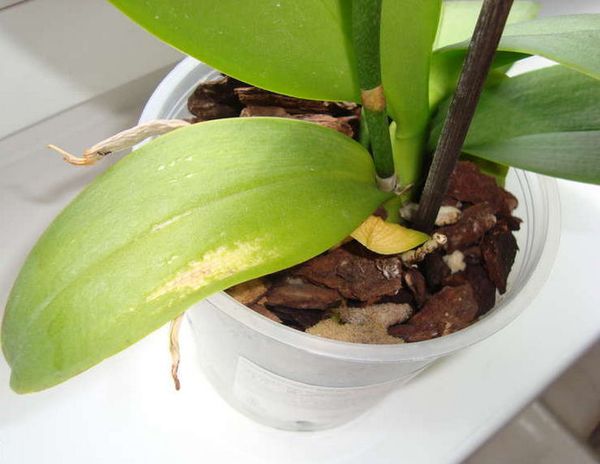

To solve this problem, you need to transplant the plant into new soil. The soil becomes dense, dries up due to regular watering, salt deposits, the growth of fungus and mold. In such a soil there are few nutrients needed by a houseplant. Overdried soil can kill the plant.
The orchid cannot be watered on schedule. An individual approach is required here.
Temperature, humidity and light levels change every day. Therefore, determining when to water can only be determined by the condition of the soil. It should always be loose to provide oxygen access to the roots, and moderately moist. Do not make a "swamp" in a pot.
Regulating watering
If phalaenopsis is watered uncontrollably, then the first thing that comes under attack is the roots of the plant. Further, the pathological process gets to the trunk, leaves and flowers wither and fall. The lack of watering is no less destructive - the roots become dry, and the orchid dies over time.


To prevent this from happening, water your orchid only when the earthen lump in the pot has begun to dry out noticeably.Pay attention to the air temperature in the room, the level of humidity - all these factors have a direct impact on the frequency of watering.
Useful tips for caring for your orchid
Experts give the following helpful tips for caring for these beautiful indoor flowers:
- Do not worry about the roots sticking out of the pot. This phenomenon allows the plant to absorb moisture from the air, so it is necessary to regularly spray the roots with filtered warm water.
- There is no need to plant this exotic flower in ordinary soil. Chopped tree bark, which can be purchased in specialized stores, is optimal as a soil.
- Watering orchids is best done in this way - place the pot in a container with settled water for 20-30 minutes. After, when the excess liquid drains, the plant is returned to its permanent place.
- Succinic acid will help to induce vigorous flowering. To do this, 1 tablet of this agent is dissolved in water, and then the plant is sprayed with the resulting liquid.
- The light mode should be at about 12-14 hoursotherwise the plant may not bloom.
- After the orchid has completely bloomed, the top of the stem should be removed with a sharp knife. so that the distance to the nearest living bud is about 1.5–2 cm. Over time, a new shoot will grow from such a bud, which will give color. The flowering process will occur earlier than if you wait until the old shoot is completely dry and the plant gives a new one.
Did you know? Orchid, according to Feng Shui, means abundance, growth, beauty and purity, as well as the pursuit of excellence.
Withering foliage of orchids can be a signal of inadequate maintenance conditions, improper watering, abuse of fertilizers, the need to change the soil, the presence of root diseases or pests. It is important to correct the content errors in a timely manner and monitor the condition of the flower.
We normalize fertilizer
You should not be too zealous with fertilizers: if their concentration is high, then the roots of the orchid become thinner, dry, change color. As for the leaves, they lose their elasticity, become lethargic, turn yellow. As a result, the orchid inevitably dries up.
If you notice the slightest signs of pathological changes in the root system, immediately stop feeding and start saving the plant: the affected roots and leaves must be removed, and the orchid must be moved to clean soil. Fertilizers should be applied no more than twice a month (in summer), and twice less often in winter.
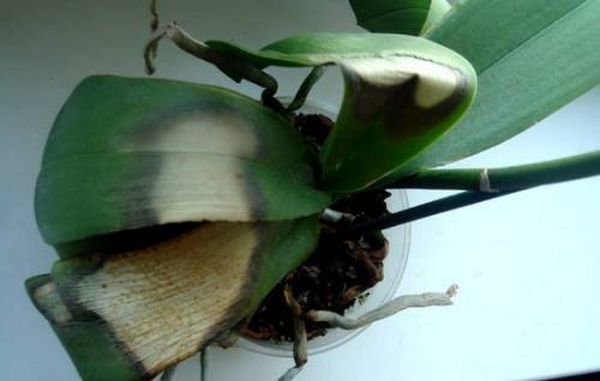

Phalaenopsis orchid leaves wither - what to do?
Phalaenopsis orchid loses the elasticity of the leaves, they wither, go down and become flabby. What to do in such a situation?
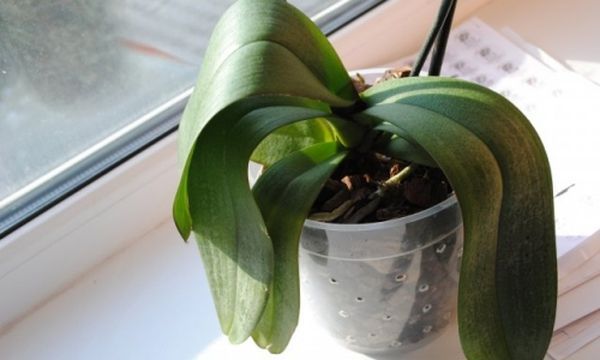

If you overdo it with watering and feeding the plant, the leaves of the orchid will fade.
Novice growers usually panic and water and feed the plant abundantly, but this is - wrong solution to the problem.
Sometimes such "salvation" only aggravates the situation, the orchid can perish completely.
In order to really help the plant come to life, you should understand the causes of wilting leaves and only then start recovery process trunk.
Phalaenopsis leaves can be withered for several reasons:
- Insufficient watering;
- Excess watering;
- Damage to the root system;
- Overheating of the stem;
- Hypothermia;
- Oversupply of applied fertilizers;
- Diseases and pests.
Rehabilitation procedures are selected depending on from the causes lethargy, each of the reasons has its own way of rehabilitation. There is no universal method.
All reasons usually arise due to improper care, this is what provokes wilting.
If you don't fight this, then you can lose a pet in a pot.
Getting rid of pests
The indoor orchid also dries up because it is attacked by insect parasites.There can be several varieties of them:
- scale insect - poses the greatest danger to the orchid. The insect feeds on the sap of the plant, which necessarily leads to a slowdown in growth and its subsequent death. If an orchid dries up because of this harmful insect, there will certainly be small brown bumps on its leaves;
- aphids - can appear on those plants that live in conditions of lack of moisture and nutrition. The danger of aphids lies not only in the fact that, like a scale insect, it feeds on sap: it is capable of infecting the orchid with toxic substances, due to which green and healthy plants gradually turn into a drying dull mass.
To get rid of pests, the affected plant must be immediately isolated and thoroughly "redeemed": rinse each leaf and root under running water, removing everything that has undergone significant damage. Next, the orchid is sprayed with an insecticidal composition, and after completely getting rid of the "guests", it is transplanted into a fresh substrate.
How to prevent wilting?
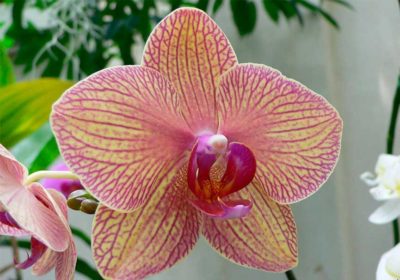

Only proper care can prevent orchid wilting.:
- The duration of daylight hours for phalaenopsis should be at least 10-12 hours. If necessary, the lack of natural light can be compensated for with artificial light.
- Temperature drops of more than 5 degrees are unacceptable, while it should not fall below +15 or rise above +30.
- The preferred air humidity for an orchid is 60-80%. With the exception of the flowering period, Phalaenopsis can be sprayed up to 5 times a day.
- Timely watering. On average, orchids need to be watered by immersion once a week, and it is imperative that the substrate dries out.
- During the flowering period, you need to fertilize the orchid 2 times a month, the rest of the time as needed.
In addition to wilting, other leaf diseases may occur in phalaenopsis: spots, sticky plaque appear. What to do to save a flower - read on our website.
Compliance with these simple rules will prevent the orchid from withering and give it the opportunity to adapt in our climate, which is so unlike its native one. An attentive attitude to tropical beauties will allow you to notice the first signs of malaise in a timely manner and take the necessary measures before the process becomes necessary.
If you find an error, please select a piece of text and press Ctrl + Enter.
We treat diseases
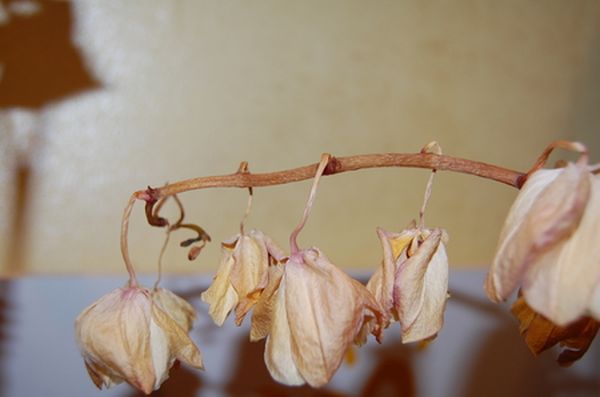

If we talk about diseases, then most often the orchid dries up due to the fact that it is exposed to fungal infections provoked by improper maintenance or care conditions. Then, as a rule, the root system rots, and the aboveground part of the plant dries up. The first thing to do is to reduce watering, and revise the roots, removing everything that has suffered. After that, we transplant the plant into a new substrate, and subsequently adhere to the watering regime.
Hypothermia
Orchid is a tropical plant, it is sensitive to indoor temperature conditions. Staying a plant in a draft or at sub-zero temperatures leads to the fact that the leaves wrinkle, their elasticity decreases, they gradually lose all moisture and sink.
In winter, the pot with the plant is not placed on the windowsill if the temperature outside the window reaches -15 ° C. Completely frostbitten leaves are not treated, they are cut off to avoid the formation of rot and its spread to healthy tissues.
It is not necessary to transplant a supercooled flower. If the orchid has soft, sluggish leaves, you can save them as follows:
- Examine the root system, the dead roots are removed, the sections are processed.
- If all the roots are frozen over, they can be grown. For this, the flower is dipped into the solution. In 1 liter of warm water, dilute at choice: 1 ampoule of "Etamon", 1 drop of "Radifarm", 4 drops of "Tsikron" or 2 drops of "Ribav-Extra".The roots will grow back in 1-2 months if you put the plant in clean water, a mixture of bark and moss, in clean moss, or organize a mini-greenhouse, for example, from a plastic bottle.
- Return the flower to dry substrate.
- Provide moderate watering and fertilization.
Orchid resuscitation
What if the orchid is severely damaged, or even almost dried up? First of all, we take the plant out of the pot and cut off all the buds and leaves. Now we examine the root system: we need to leave only healthy shoots, we mercilessly remove everything that is rotten and dried up. After that, we treat the roots with a phytosporin solution to prevent the development of infections. Now you can plant the orchid in new soil, and try to provide it with the right conditions.
Now you know how to save your pet so that it does not dry out completely.
Prophylaxis
The process of restoring a flower should begin with the fact that you need to move it. If the flower is, as they say, "out of place", then it needs water procedures. First, water by dipping the pot into a container of warm water. Let the flower stand in the water for about an hour. Next, give the plant a warm shower. Be careful: water should not get on the peduncles. After the bath procedure, the sheet plates should be wiped dry with a cloth made of natural material. Locate the orchid in a warm place, but not in direct sunlight to avoid scalding. At this time, it is not recommended to water the flower with means for growth, otherwise the situation can only be aggravated.
Symptoms of improvement should appear after three days. If this does not happen, you should take up the roots. The plant must be removed from the pot and the root system must be carefully examined. Healthy roots will have a bright green color. All dried and rotten roots are removed with a sharp knife to healthy tissue. After this, the cut sites are sprinkled with charcoal or activated charcoal.
The orchid is not only a beautiful, but also a very capricious flower. Failure to follow the rules of care can lead to the fact that the leaves wrinkle, lose their shine. The main thing is to put the flower in a well-lit place, water it, check the moisture content of the soil, replace the substrate during transplantation and treat it on time from pests.
Why do the stem and leaves dry?
There can be several reasons for the drying of an orchid, but the most basic are:
- Overheat. The plant overheats in case of direct sunlight. It is quite simple to determine overheating - the leaves dry and turn yellow, and the roots acquire a brown tint and become much thinner than normal.
- Poor watering. An orchid is a plant that not only does not tolerate overflow, but also does not like drying out. With excessive watering, root decay begins, which subsequently leads to the drying of the stem and leaves.
- Fertilizers. Many growers mistakenly believe that the more thoroughly the orchid is fertilized, the better, but this is not the case. With excessive fertilization of the soil, the root begins to die, gradually reaching the stem and leaves.
- Pests. This is another common cause of orchid wilting. It is possible to determine that the plant has been attacked by pests from the appearance of plaque and small light spots on the leaves.
Read about why the roots of an orchid dry and how to help the plant, and from this article you will learn about the reason for the drying of flowers and what to do to prevent the secondary occurrence of the problem.
Why is it happening?
Shrinkage can be either natural or due to disease or oversight. The natural drying process is as follows:
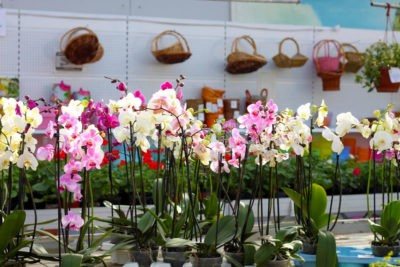

Having bought a flower in a store, its owner does not know exactly when the orchid bloomed. It is very possible that the flowering stops in the most natural way. The first to dry are those flowers that bloomed earlier - there is a "sudden" discharge.- The leaf is also not eternal, and also someday turns yellow and dies - everything has its time.
The unnatural drying process looks like this:
- All the leaves fell off. The first sign is the yellowness of the leaf plate, in addition, blackness in the attachment points. The process can be both normal and abnormal. This can be understood early on in the process.
- Roughness of the leaf - a flower in a healthy state has only smooth plates. This symptom speaks of tissue destruction in the early period. Urgent measures are simply indispensable here.
Reference! The orchid throws off the old leaf from time to time, and this process is quite natural, that is, the norm. This is directly related to the life cycle of the plant. The leaf turns yellow gradually, becomes bright yellow, then wrinkles, and before drying, it turns black.
The process starts from the lower leaves. Dying off naturally occurs for quite a long time - a year and a half. This also happens during the flowering period (only with some varieties of this plant) - the green mass can also change color before subsequent shedding. It is likely that the flower is in a state of hibernation - a state of rest.
The difference between natural processes and the effects of external factors lies only in the duration of leaf death. Moreover, with a natural process, there is no massive leaf fall, and this does not in any way affect the state of the plant as a whole.
So it is not so difficult to understand the nature of plant drying.
Do I need to process with funds?
The orchid is quite resistant to the development of diseases and the appearance of pests, however, problems sometimes do occur.
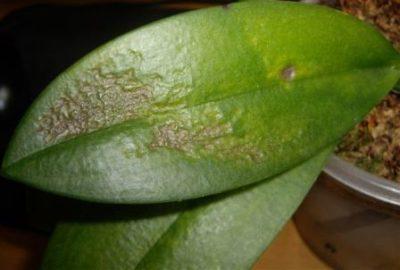

One of the most common problems that orchids are prone to is the appearance of rot on the leaves. This is due to excessive soil moisture or frequent spraying. The plant in this case is not easy to cure, since not only the leaves, but also the entire root system are exposed to rot.- If putrefactive areas are found, it is necessary to cut them off with a sharp knife, having previously disinfected it. When cutting, you need to capture a part of the healthy section of the flower.
- After the damaged area of the plant is completely removed, the cut must be treated with a special bactericidal solution, and then transplanted into another container, completely replacing the soil.
- In addition to mold, orchids can also be infested with pests.The most common of these are mealybugs and spider mites. If there are few insects, then it is quite possible to get rid of them with soapy water. Having prepared a solution of laundry soap and water, they need to wipe each leaf of the plant, the procedure must be done 2-3 times, and repeat again after a week.
If the plant is defeated by pest infestation strongly enough, then it must be treated with such means as Aktar or Fitoverm. These care products are sold only in specialized stores.
What does a dried peduncle look like?
In the drying phase, the arrow loses its rigidity and elasticity. At this time, her appearance changes smoothly: the green tone gradually fades and fades. The peduncle loses its shape and becomes purple or brown.
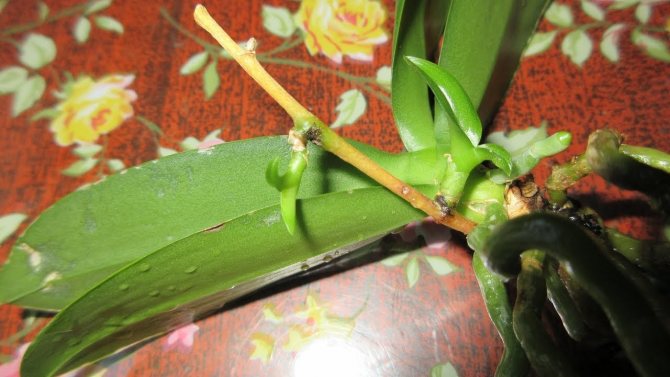

There is no refreshing moisture in the drying part of the plant. Photosynthesis and other life processes stop in a dried pedicel. Simply put, the extinction of this part of the flower occurs.
Determination of the prerequisites for drying a particular plant
This can be done visually. If the conditions for growth are optimal, it is necessary to carefully examine the plant, first of all, for parasites or diseases.
In case of improper cultivation, double-check your actions and try to find a mistake. A detailed inspection includes the procedure for removing the orchid from the pot.
It can also happen that the plant was flooded, the roots rotted and therefore it is experiencing a moisture deficit.
First signs
Dry, yellowed, lethargic leaves are the first noticeable sign of orchid disease. Sometimes the foliage just falls off. If no more than 2 leaves have fallen within a year, this is considered the norm. The appearance of the peduncle and buds will also tell about the health of the plant:
- if by the end of flowering the petals of the bud began to fall off, and the peduncle gradually dries up, this is considered a natural process.
- the plant needs treatment if the buds are full and look bad.
The flower receives all the nutrients through the root system. This is its main organ that synthesizes solar energy. The color of the roots of a healthy plant is grayish or pale green; after watering, it acquires a bright green, saturated color. An unusual shade, indicates drying and death of the roots.
Factors Affecting Root Damage
Damage to the root part is immediately reflected in the aerial part of the orchid.
The root system can be damaged due to the following reasons:
- Excess or lack of moisture;
- Use of concentrated fertilizers;
- Compaction of the substrate;
- Poor quality soil - substrate.
Concentrated fertilizers do more harm than good. They are too saturated with active substances and all kinds of salts.
The sensitivity of the roots reacts negatively to them and causes rotting.
Important! It is necessary to apply only special fertilizers - "For orchids".
Phalaenopsis easily tolerates a slight drought, but gets sick from waterlogging.
From excessive moisture, the roots begin to rot immediately.
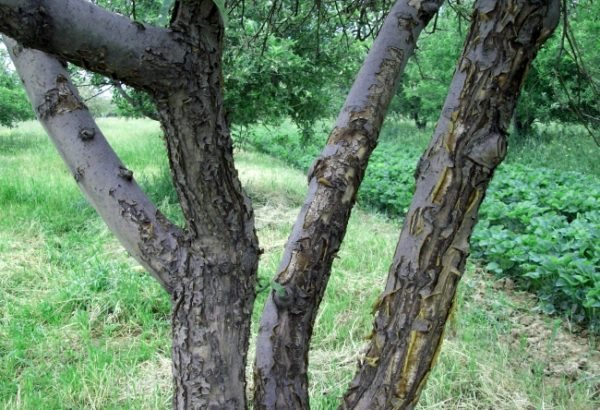

Overmoistening the orchid can damage the root system.
Therefore, between waterings, the roots should be allowed to dry well. It is required to adjust the watering for each type of phalaenopsis.
Insufficient watering
Under insufficient watering, too long drying of the roots is considered.
The velamen covering the roots loses its ability to absorb water and the roots dry out, ceasing to provide nutrition to the upper part of the plant.
A rare but common occurrence. Occurs with an incorrectly selected fraction or if the soil has become clogged with soil fungi, algae or salts.
There is a violation of air circulation in the root of the orchid, which negatively affects its condition and the condition of the leaves.
The substrate mainly consists of coniferous bark.
Incompletely digested bark can contain resins that not only harm the roots, but also impair aeration.
A poor-quality substrate can contain a considerable number of pests or pathogenic bacteria. Such soil causes a disease of the root system and can subsequently destroy the plant.
Dense substrate
Air must always circulate between the roots of the orchid. This is a prerequisite for a flower, in addition to a moist environment in a pot. If the leaves of the phalaenopsis are shriveled, the cause may be a dense substrate.
The substrate for the orchid should be loose.
The loose substrate provides ventilation of the roots, they remain healthy, do not rot, excess moisture is easily removed. If the orchid withers, then these conditions are not met.
The cause of leaf wilting is eliminated by completely replacing the substrate. Properly processed, quality bark easily absorbs water, filtering it through its pores.
When this phenomenon is not normal
If the peduncle turns yellow after the flowering phase, this is quite natural. If the arrow dries up while buds appear on it, this is already abnormal - the flowers will not be able to open. In this case, one should look for the reasons, reconsider the conditions of detention and the mode of care.
Also learn how to care for your orchid after flowering.
Is it worth cutting off a dried peduncle and is it necessary to transplant
You can completely cut the pedicel only when all the rudiments on it are dry.This is an indication that the peduncle has fulfilled its mission and it can be cut with confidence to give the plant the opportunity to rebuild for the next flowering. Cut the arrow carefully, near the outlet, being careful not to damage it.
Did you know? Some types of orchids grow on trees. But at the same time, they do not parasitize, but use the tree as a support. Other species grow on rocks, clinging to cracks with their roots.
Pruning is done with sharp scissors (regular or garden scissors). After cutting, the cut site is disinfected so that the plant does not develop diseases. To do this, you can take cinnamon powder, activated charcoal or charcoal.
If the reason for the drying of the pedicel was insufficient watering, then the situation is corrected in another way: the watering mode is chosen correctly. The lack of moisture is indicated not only by a dried peduncle, but also by lifeless, faded leaves.
If the root system of the flower is waterlogged, then it is necessary to transplant it. Root branches are well cleaned of soil, disinfected, and dry parts are cut off. After a certain time, the plant will fully recover and shoot a new arrow.
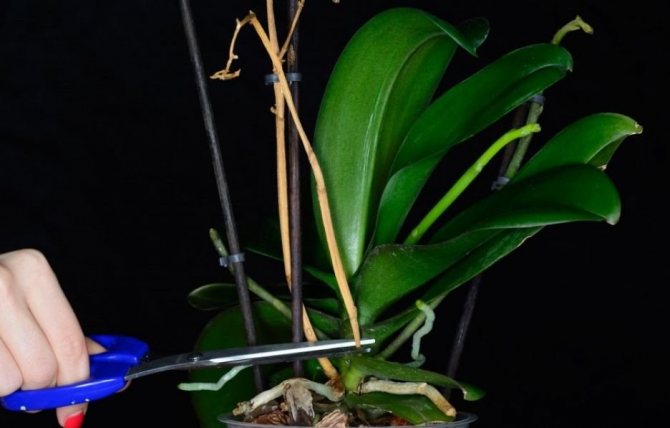

Soil for orchids should include the following components:
- pine bark or cones;
- charcoal (no more than 10% of the substrate);
- leafy ground;
- sphagnum moss.
It is better to choose a container for a flower made of clay or plastic. These pots provide good air exchange and moisture distribution. The disadvantage of such containers is the rough surface to which roots can sometimes grow. For beginners, it is better to choose a plastic transparent container. Through its walls, you can monitor the condition of the roots.
Did you know? Unlike many flowers, orchids are non-allergenic. Their aroma is very varied: from light notes of honey and vanilla to the smell of rotten meat.
Falling unopened buds
If the unopened orchid buds wither or fall off, it is necessary to control watering, stabilize the microclimate around the plant, then examine it for insects and infections. For this:
- The orchid is removed from the pot, the roots are dipped in warm water and soaked.
- All roots are probed and examined for damage. All dry, soft and sore areas are cut off with a sharp, pre-disinfected knife.
- Places of cuts are treated with crushed activated carbon or ground cinnamon. Do not use products that contain alcohol.
- To kill the infection, the plant is treated with a fungicide, then planted in a small pot of new soil, enriched with minerals. A drainage layer is placed on the bottom of the container.
- The first feeding is applied 14 days after planting.
Interesting! Phalaenopsis can grow in a flowerpot with water if it is provided with good lighting for up to 12 hours a day.
What is the danger for the plant?
Despite the fact that the orchid is a very beautiful exotic plant, some of its species and varieties cannot be brought home, as this can be fraught with mortal danger. This is due to the fact that some orchid varieties contain poison, contributing to the development and rapid growth of cancer cells.
Important! If there is a poisonous plant in the house, then the vapors of the poison are not carried through the air, but are transmitted through direct contact with infected areas and when the poison enters the mucous membrane. Therefore, gloves should be used when cultivating the soil or when transplanting an orchid.
Despite the fact that cases of infection with a plant such as an orchid are extremely rare, at home it is still better to grow a flower designed specifically for such conditions.
Pruning
A faded orchid must be cut according to the rules so as not to destroy the plant.
When to prune your orchid
The time from early October to November inclusive is considered the best period for this procedure, and it is suitable for almost any type of this wonderful plant. But, exotic species (artificial hybrids) are pruned only in the spring, from the first days of March until the end of the month. The name of the flower indicates a hybrid or original variety.
Therefore, when acquiring a phalaenopsis for yourself, be sure to pay attention to the name (or write it down), because his whole future life in the house will depend on it.
Using tools when trimming
Oddly enough, but better for this are scissors for metal or a simple garden shears for pruning - pruning shears.
Be sure to disinfect the tool you decide to use with a solution of ordinary bleach. Try not to prune with a knife, as you can easily accidentally damage the leaves.
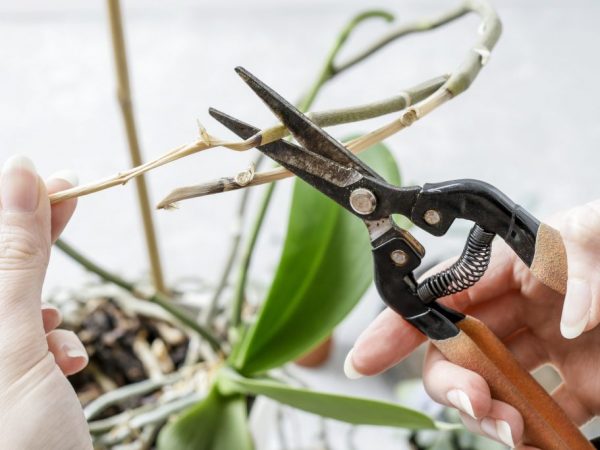

A faded orchid must be cut according to the rules so as not to destroy the plant.
Pruning rules
First of all, carefully examine the flower, check for dormant buds, from which children or new flowers can grow.
- In order for the phalaenopsis to bloom again, you need to count down three dormant buds and about 10-15 mm above the last and cut the peduncle there. Please note that this pruning method does not have a 100% guarantee that this peduncle will have buds or kidneys of children.
- In addition, if the peduncle is cut from above in this way, then there is a chance of a flower emerging, but a new trunk is unlikely to grow, because the plant will use all its resources to support the old stem.
Pruning the entire peduncle
A yellowed or completely shriveled stem must be cut off entirely, leaving only a small piece no more than 20 mm in size. Do not feel sorry for cut peduncles, because soon Phalaenopsis will again delight you with its beautiful flowers.
Orchid after pruning
Caring for such a phalaenopsis is no different from the usual. You just need to fertilize the plant with top dressing to accelerate the growth of new leaves and the appearance of flowers. If the plant is resting after flowering, then you should not add fertilizer during this period.
What to do
First, determine the cause of the wilting of the leaves.
They try to gently lift the orchid out of the pot, holding the trunk. The plant must sit firmly in the ground.
If everything is in order, rearrange the flower to another place: remove it from the windowsill and put it away from the window.
Experiment with watering. With a dry surface of the soil, watering is increased, with a wet surface, it is reduced. It is convenient to control the moisture level when the plant is in a transparent pot. The roots have changed color from green to silver - it's time to water.
Several important points about the irrigation regime.
After the end of flowering, the orchid is not watered for a month. In nature, at this time, it spreads seeds through dry air.
Before and during flowering, the plant is watered more often.
The optimum air humidity is 60%. Therefore, the flower needs to be sprayed.
If you overdid it with fertilizers, you need to transplant into a new soil. Be sure to use a special orchid substrate.
For reference! A substrate is a mixture of earth made up of various natural components and their substitutes. For orchids, they buy special soil, or they make it on their own.
After transplanting, the leaves wither due to:
- the wrong pot size,
- a sharp change in the composition of the substrate.
Too large a flowerpot causes acidification of the soil, too small does not allow the roots to "breathe".
An orchid is a living organism. Therefore, she may not like any composition of the soil.
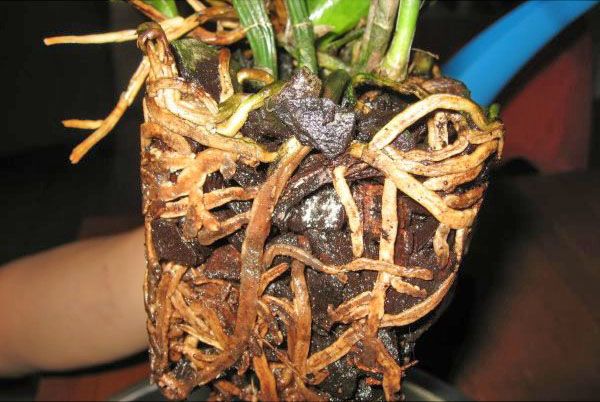

One of the causes of sluggish leaves is root problems.
When the roots are blackened, the watering regime and lighting are adjusted. There should be enough air for the flower.
Sometimes leaf wilting is a response to stress. In the store, the orchid is accustomed to a certain microclimate, and must adapt when changing it.You should wait a little and keep the plant in "quarantine".
If the root system is in order, there is enough moisture and air, the temperature is 25-32 ° C, the soil is fresh and there are no parasites, do the following.
Dilute 3 teaspoons of sugar in a glass of water. The solution is used to wipe the lower parts of the leaves of the plant and leave overnight. Sugar retains moisture. In the morning, the solution is removed from the leaves, allowing the plant to breathe.
Note! The method is used when the leaves of the orchid are not damaged.
The purpose of the flowering shoot
The peduncle is an appendage on which inflorescences are formed. The orchid throws out such an arrow immediately after the end of the dormant period, when the flower has rested and gained strength. After the ejection of the pedicel, the flowering phase begins: ovaries are formed, which later grow and bloom. This is where the peduncle's mission ends.
Important! You should not cut the flowering arrow immediately after flowering. When it is strong and green, new flowers may soon appear on it.
Lack of roots
You should not throw out a flower that is left without roots, it can be reanimated by creating a small greenhouse. This can be done in 2 ways:
- Method A: A layer of expanded clay and moss is placed on the bottom of a wide container. Wild moss cannot be used, as various parasites and microorganisms can live in it. Better to get it at a flower shop. The orchid is laid on top of the moss, covered with a glass jar or plastic container on top. The humidity and temperature inside the greenhouse will rise.
- Method B: Water is poured into a container and the orchid is immersed in it so that only the lower tip is in the water. The flower should remain in this position for at least 12 hours. Then the water is drained, and after 12 hours it is again immersed in the liquid.
Advice! You can purchase a special pH test to determine water hardness at a pharmacy, online or at a pet store. You can soften the water by incomplete freezing. When frozen, a brine consisting of dissolved salts will appear around the piece of ice. This brine is drained, and melted ice is used for irrigation.
